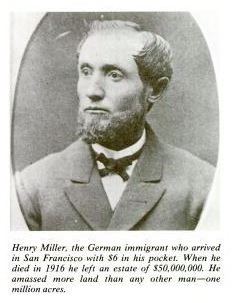Name Henry Miller | Role Rancher | |
 | ||
Died October 14, 1916, California, United States Books Account of a tour of the California missions & towns, 1856 | ||
Perros de tonaya acustico henry miller noche de maderas
Henry Miller (July 21, 1827 – October 14, 1916) was a German-American rancher known as the "Cattle King of California" who at one point in the late 19th century was one of the largest land-owners in the United States.
Contents

Life and work
Born in Brackenheim, Germany as Heinrich Alfred Kreiser, he immigrated to New York City in 1846, where he worked as a butcher. He came out to California in 1850 under the name Henry Miller, a name borrowed from the non-transferable steamer ticket he had purchased from a friend in New York.
Miller built up a thriving butcher business in San Francisco, later going into partnership with Charles Lux, also a German immigrant and a former competitor, in 1858. The Miller and Lux company expanded rapidly, shifting emphasis from meat products to cattle raising, and soon became the largest producer of cattle in California and one of the largest landowners in the United States, owning 1,400,000 acres (5,700 km2) directly and controlling nearly 22,000 square miles (57,000 km2) of cattle and farm land in California, Nevada, and Oregon.
The Miller and Lux Corporation was headquartered in Los Banos, on the west side of the San Joaquin Valley. Miller played a major role in the development of much of the San Joaquin Valley during the late 19th century and early 20th century. His role in maintaining and managing his corporate farming empire illustrates the growing trend of industrial barons during the Gilded Age. His detailed correspondences with Superintendent Turner reflects his micromanagement business style and underscores the lack of autonomy of rural farmers in the region. Miller persistently corresponded with his subordinates in order to verify that all the cattle met his standards before being sold. The correspondences demonstrate his attention to detail, especially in regards to the weather conditions and the amount of food and water the ranches contained. In 1910, his upstream water rights to the San Joaquin River, which crossed much of the company's land, were acquired by the Big Creek Hydroelectric Project; the project's planned reservoir storage of snowmelt would greatly reduce flooding and increase river flow during the dry season.
At the time of his death, in California, Miller's estate was appraised at some US$40 million dollars, somewhat less than during his prime. The Miller and Lux Corporation did not long survive his death, though his grandson George Nickel reorganized the holdings and became a large farmer and land developer. Some of his descendants continue to farm in the area around Los Banos and to operate as farmers and land developers in Bakersfield and Kern County.
